Through the media, we are aware of spirits, ghosts and creatures beyond our comprehension. We understand that they have a reason behind what they do. They are not evil or good by nature, but driven in those directions. Countries around the world have their folklore about what haunts them at night, each with its own agenda.
Repeat
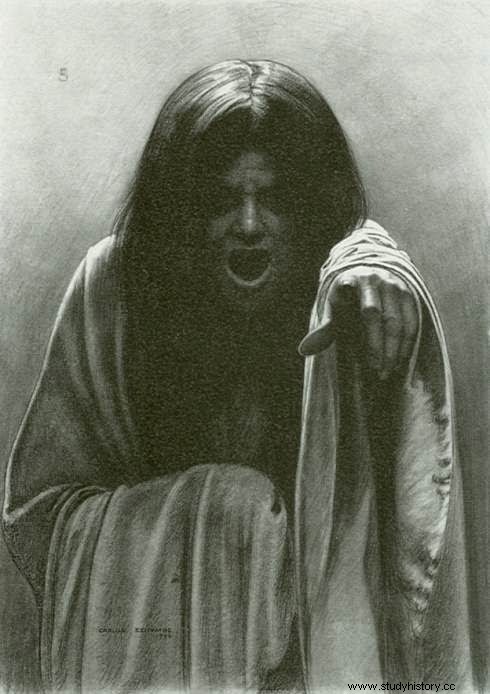
In Norwegian, again means 'again' and times means 'foot' or 'walk'. All in all, recurring means 'go again'.
This is a ghost that Scandinavians fear becoming.
Targeted brought back, the ghost haunts the living. Usually they look physical (human) and not ghostly at all. They have no spirit-like qualities. Therefore, they are not typical ghosts.
Those who died before their time, be it murder, suicide or another incident, return as a vengeful ghost. Motivated by revenge, they are extremely evil. Their goal is to disrupt the lives of those who did wrong.
Often it is a spirit that left something undone. However, they are not as vicious and require help to pass on.
Repeat like to spread chaos among the living. It spreads disease through plague and disease.
Originally, this was a Viking legend. Conflictingly, the ghosts were half-dead. It was possible for a man to kill one.
Killing punch
Translated:'dead man's hug'.
When it is squeezed by the ghost, the victim's skin turns blue when the infection begins. Then the meat becomes gangrene. Slowly the infection reaches the heart and kills the victim.
When the victim is asleep, they are at their weakest. That's when the ghost strikes.
These ghosts pursue their prey during the comfort of the night. They are intelligent, cold and ruthless.
It acts as a warning against sleeping in certain places, such as near cemeteries, mountains or water.
Ways to avert G jenganger
Even when you are pursuing, an encounter with the ghost can be averted. Holy symbols repel the creature. Holy smoke over the door prevents it from entering. Crosses worn around the neck can prevent death knots .
In addition, only locking windows and doors will prevent the ghost from entering. Without ghost-like abilities, they can not phase through walls.
Precautions
In addition to averting the ghost, there are steps to prevent the deceased from becoming so.
First, the coffin is carried over the church and around it three times. The shovels remain undisturbed at the burial site. A warp is a pile of sharp stones and twigs, placed at the place where the person died. Adding a rock after passing a warp brings good luck.
The inscription inside the coffin:
«For Birginga, his brother carves runes
My dear sister, shån mag! ”
“For Birginga, his brother earned runes
My dear sister, save me! ”
Krasue
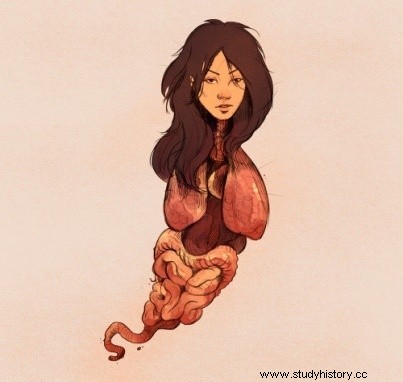
A nocturnal female spirit in Southeast Asia, mainly in Thailand, Cambodia, Laos, Indonesia and Malaysia.
With the appearance of a young woman, the intestines (internal organs) hang down from her neck, behind under the head.
Legend
A Khmer princess and a Siamese nobleman were to marry after his people conquered her country. Despite the arranged marriage, she fell in love with one of the conquering soldiers. When the Siamese nobleman was captured by her boyfriend, she sentenced her to death.
Before the execution, she had a witch who conjured over her to be unharmed by the flames. However, the spell came into force too late. The majority of her body burned, except for her head and some intestines.
The accursed non-charred remains have an eternal hunger. The spirit hunts and attacks at night. To satisfy its gluttony, it seeks blood to drink and meat to eat.
Attack Method
It primarily attacks pregnant women or newborns. If one of these can not be found, it will eat animals and feces.
It hovers around the pregnant woman's house and shrinks sharply to create fear. With its long tongue, it reaches the fetus or placenta in the womb. It is believed that the spirit is partly responsible for the spread of disease among pregnant women in rural areas.
If the newborn is caught, it will be swallowed.
protection
Around the house are thorny branches, which prevent the spirit from entering.
After the birth of the newborn, relatives must hide the placenta. It is buried deep enough that the spirit cannot find it.
Weaknesses
The spirit hides its body, only to rejoin during the day. This allows it to interfere with the living.
If krasue joins the wrong body again, it suffers torment to death.
There are three deadly ways to get rid of the spirit:
- the spirit does not find its body, or
- the intestines and head are separated, or
- the headless body is broken.
Kuchisake-Onna (uch 裂 け 女)
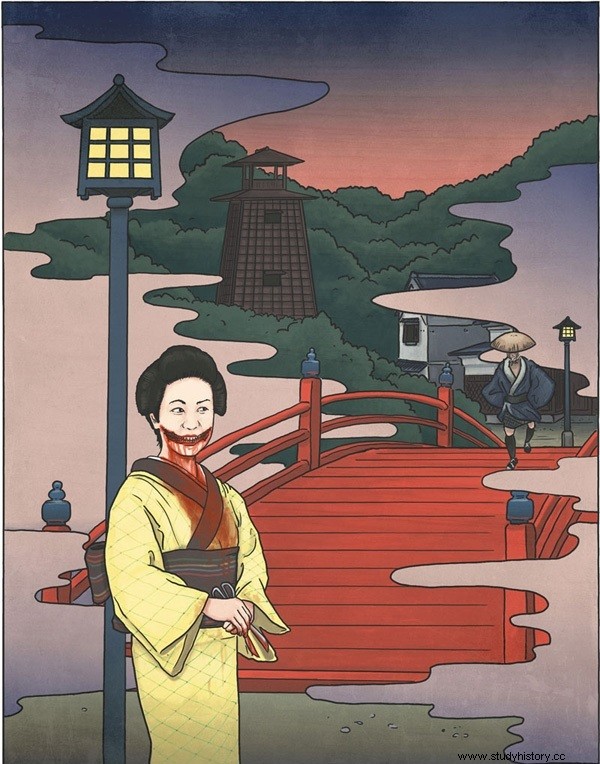
Translated to 'split woman'.
The ghost of a mutilated woman who avenges the world.
Running across her face, from ear to ear, is a deep, bloody gash.
They are spirits of death, killed in a violent way, who are often not well.
There are many stories about how she met her unfortunate fate:
- Her husband cut her face because of her infidelity.
- Something went wrong during a medical or dental procedure.
- A woman, jealous of her beauty, cut herself in the face.
After death, she returns as a vengeful spirit.
Attack Method
When he sees a lone traveler, the ghost covers his face with a cloth mask, fan or handkerchief. When the traveler approaches her, she asks if they think she is beautiful.
The traveler answers yes. The ghost removes what hides her face and asks again.
If they say no or scream in fear, she strikes the traveler with a knife or scissors from ear to ear.
If the traveler answers yes, a lie, the ghost disappears. Still, the traveler continues home, only to be followed by the ghost. Once inside, the ghost kills the traveler.
Escape methods
These are reputable methods, it is unclear if they are really successful.
One method is to confuse the ghost with ambiguous answers. For example, you look average or uneven. While the ghost is lost in the mind, the traveler can escape.
If the traveler tells her they have a previous engagement, the ghost will pardon her behavior and apologize.
When fruit or candy is thrown at her, she will pick it up. The traveler is now distracted and has time to flee.
La Llorona
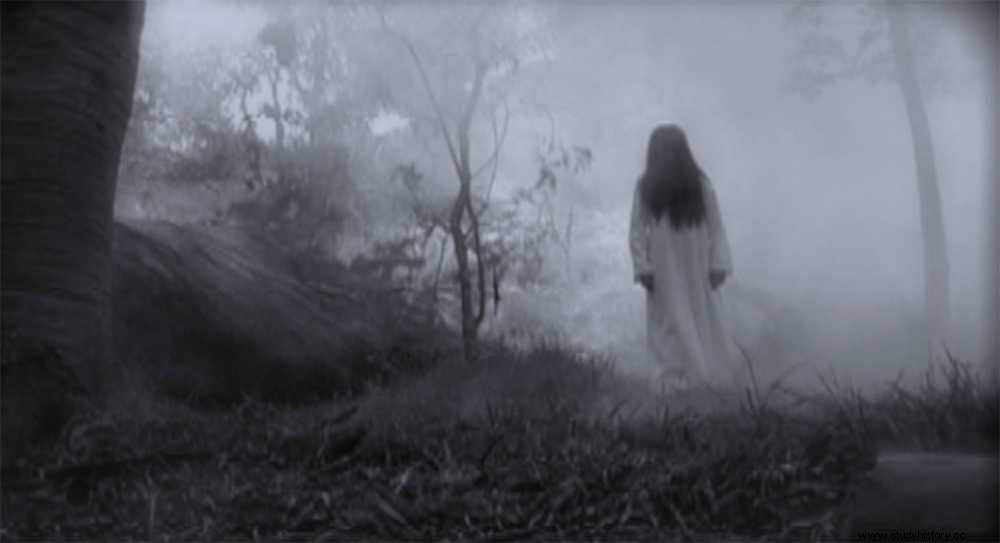
Translated to 'the crying woman', she is a banshee-like appearance, dressed in white. She is often by lakes or rivers, sometimes at intersections.
Parents consider her a "villain" and tell her story to make sure her children behave. In one version of her story, she kidnaps or attacks children behaving badly. On the other hand, her target is unfaithful husbands or those who do not treat their families well.
Legend
It is an obscure origin of the Mexican revelation; the legend varies. However, some aspects of the story are similar.
A Mexican woman, Maria, was blessed with natural beauty. After searching for a potential husband, they had two children. Although this is speculated, her infamy lies in the fact that she drowns her children.
The reason for the drowning lies in the husband's chores, which are also different:
- He became distant from Mary and thought of his wild and free life before marriage, or
- An extramarital affair, or
- Mary disliked her apathy towards her, compared to his devotion shown to their children.
The drowning incident is depicted in three different circumstances.
The first, her rage against her husband, led her to neglect her children. When playing near a river, they fell and drowned. When she saw her biggest mistake, she drowned herself.
The other she drowned her children, either out of rage or sympathy, which became an immediate remorse. Then she drowned herself.
The third she ran down the river to look for her children after they fell in. While searching, she broke down screaming and crying. She walked around the riverbank and did not eat, the white dress was dressed in mud and torn. Her refusal to eat led to her skeletal-like appearance. Yet, as a young woman, she died on the banks of the river.
As she stood before the gates of heaven, she was denied entry without her children. Exiled to purgatory, she goes to earth in search of her children, crying forever.
A lost soul, doomed to walk the earth forever, part of Mexican culture.
La Pisadeira
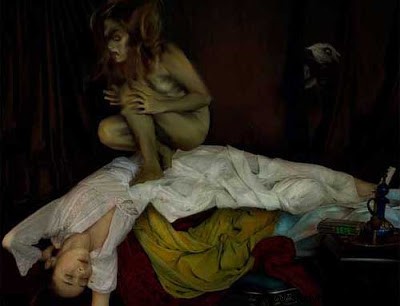
In Brazilian folklore, this creature takes the form of an elderly woman with a limp appearance. It's materializing nightmares.
The shape is a skeleton-like body; long, dirty black hair; and hands with long, sharp, yellowish, claw-like nails.
The only sound it makes is shrill laughter, the mouth always open and filled with rotten teeth. However, the laughter is only of the elect. The laughter makes the individual aware of her presence.
Attack Method
When they run on rooftops, they find a suitable time to enter a home to attack the unsuspecting victim.
For the creature, the best attack time is after dinner. Filled with food, digestion helps in drowsiness. Therefore, it is difficult for the victim to wake up.
Once asleep, la pisadeira climbs up on the victim's abdomen and chest and pushes down with the weight. The result is slow suffocation.
The victim is paralyzed, aware of what is happening, but is unable to move a muscle in the defense. Once found, it is impossible to come up with a reasonable explanation for the cause of death.
The creature grows stronger with the fear of the victims. It attacks several times, lasting from minutes to hours. This depends on the joy the creature has when it eats at a particular victim's fears.
Victims are considered lucky if it kills them the first night.
Tales of la pisadeira and sleep paralysis share similar features.
The creature is slowly forgotten and becomes weaker.
Pontianak / Kuntilanak
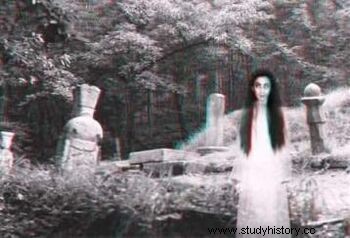
A ghost of an Indian, Malaysian and Singaporean legend.
It has the shape of a beautiful woman with pale skin, longer nails, red eyes and dark hair. She's wearing a white, blood - stained dress.
The Pontianak is a woman who either died during childbirth or in the hands of men. She returns from the dead and seeks revenge and retaliation from men.
She hunts and attacks at night, while living inside banana trees during the day.
Attack Method
To lure her prey, the ghost takes the form of a beautiful woman. The unsuspecting man falls into the trap. Then it reveals its true form. With its long nails, it sinks deep into the abdomen to tear out and devour the organs.
A child's cry indicates its presence. If a baby cries softly, the ghost is close. A child's loud cry indicates that it is far.
In addition, a dog's howls and whines are rumored to indicate its presence. If a dog howls, it is far away. If a dog is whining, it is nearby.
Another indication that the ghost emits a blossoming odor before a rotting stench.
Prevention
The only way to stop a Pontianak is to drive a long nail all the way into the hole in the neck.
If the nail remains, it will remain a beautiful woman and a good wife.
Strigoi
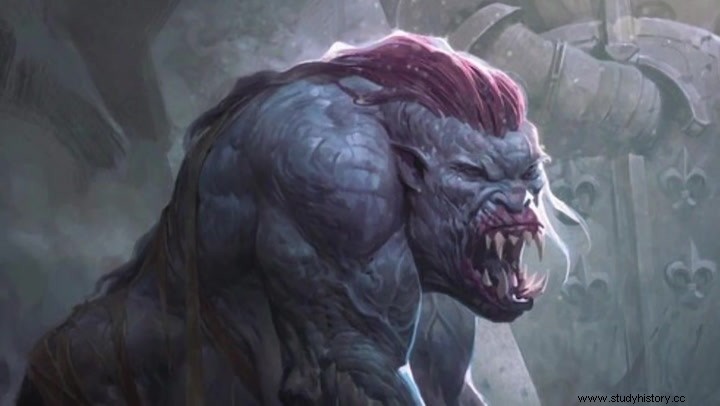
Translated from Romanian, it means 'scream'.
Restless spirits rise from the grave, possess the abilities of invisibility, transform into animals and receive life force from the blood of the victims.
The creature has red hair and blue eyes. Although the look seems standard, it stands out by having two hearts.
Types of Strigoi
With two hearts come two souls. One soul joins the other strigoi in drinking blood. The remaining soul becomes one of three types:
- Strignoaicӑ :a witch.
- Strigoi viu (liver strigoi ):a sorcerer who steals wealth from farmers, stops rain, releases hail and kills men and cattle.
- Strigoi mort (dead strigoi ):a human demon hybrid, and the most dangerous. It returns to the family as if nothing has changed, and slowly weakens relatives until they die.
Becoming a Strigoi
A living individual can become a strigoi under certain conditions. They are the seventh child of the seventh child of the same sex, or living a life of sin. They die without being married, by execution for perjury, by suicide or after being cursed by a witch.
Get rid of Strigoi
According to Lost Ties , is a well-known Romanian method of preventing the deceased from returning as a strigoi .
- Dig out strigoi.
- Remove the heart and cut it in half.
- Pull a nail into the forehead.
- Put a clove of garlic under the tongue.
- Lubricate the body with lard. The pig must be killed on St. Ignatius' day.
- Turn your body down. If they ever wake up, they're going to the afterlife.
Defeat Strigoi
There are two ways to kill the creature.
The first, a blessed effort through the heart, followed by the beheading. The right heart must be staked, the heart pumping blood through the veins.
The second, insert the heart through the body and into the ground. The creature is immobilized and set on fire.
Tiyanak
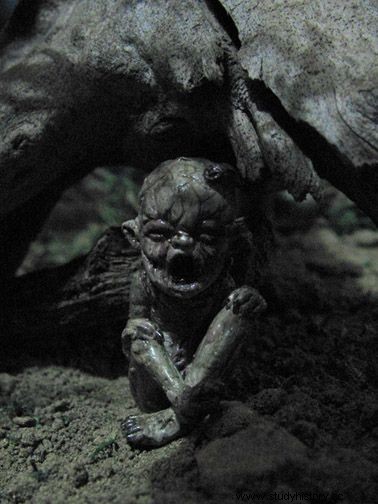
A humanoid monster of Filipino legend.
In terms of appearance, it looks like a small, bald pixie. The teeth are sharp, the ears are pointed and the eyes are bloodshot. With its disproportionate legs, the right leg is shorter and the left leg is unusually long.
Attack Method
It disguises itself as a baby, abandoned in a forest or field. It cries loud enough to attract a passing traveler. When picked up by the traveler, it covers its disguise. After revealing its true form, it kills the traveler by biting him and strangling him.
One way to escape the creature is for the traveler to turn his clothes inside out. The tiyanak thinks this is ridiculous and leaves the victim.
Origin
There is speculation about the origin of this creature, each story different from the other.
The first was the babies abortion in the forest and left there.
The other, a Catholic influenced story which refers to unbaptized newborns. If a newborn dies before being baptized, it goes to Limbo. It is transformed into an evil creature.
Given this story, it is possible it was introduced by Spanish missionaries. The purpose was to convert the natives to Catholicism.
The third, the spirit of a child whose mother died before she gave birth. The child was 'born on the ground', which resulted in his current condition.
Toys
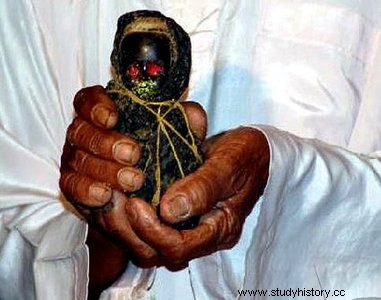
A spirit from Southeast Asian folklore, especially Indonesia, Thailand, Malaysia and Singapore.
It is the spirit of an infant who died before it was born.
A toy appears as a naked newborn with a large head, small hands and green or gray skin. Their eyes are either red or cloudy, pointed ears, with rows of sharp teeth. It's a bit like a pixie. In addition, they have monkey-like hair, although they are speculated.
According to Asian practices and beliefs, an individual's afterlife is taken care of by the family as a tablet. It is made of wood with the name of the deceased on it.
The master of toys keeps the tablet and cares about it. The spirit has the temperament of a child, and must therefore be treated as such. The master must feed it every day with drops of blood, either through the thumb or big toe. It requires encouragement and attention, in addition to offering.
The offerings are sweets and toys, just as a child would receive to be entertained.
Purpose
A toy becomes a creature that steals from others or does mischief when instructed.
The spirit is for selfish and petty reasons. For example, theft, sabotage and other minor crimes.
It is either in a jar or urn, hidden in a dark place until needed.
However, it is unclear what happens when it is not necessary. There are possible theories:
- The tablet and urn are buried in a cemetery, with the relevant rituals performed. Therefore, the spirit is put to rest.
- The tablet and urn are thrown into the sea.
- The spirit remains with the master permanently. Left behind for generations, descendants are now doomed to own it.
Weaknesses
A toy being distracted by the marble, sand and hanging garlic. It plays with the elements until it forgets the task.
For fear of their own reflection, the money is kept under a mirror.
In addition, needles are placed on top of money, for fear of being stung.
Without a master, it is no longer a threat. It remains in the jar or urn, an observer of the living.
Cultural significance in anthropology
By looking through the different legends and folklore, it gives a deeper insight into the faith of different countries. We are able to understand their customs, why it is important for them to perform a specific ritual to ward off evil. After all, it is a common factor. Everyone wants peace and well-being for themselves and their families.
“No man chooses evil because it is evil; he fails it only for happiness, the good he seeks. ”
-Mary Wollstonecraft, A Confirmation of Human Rights.
